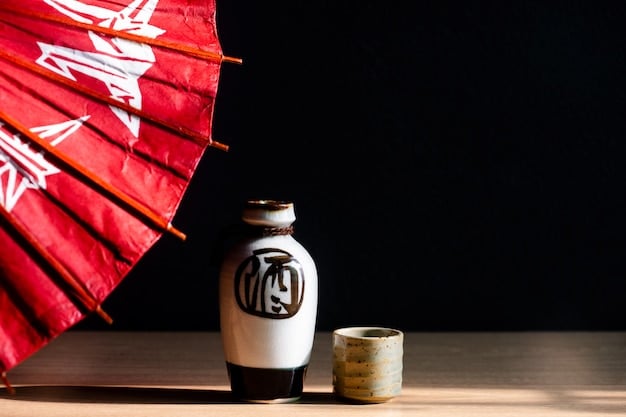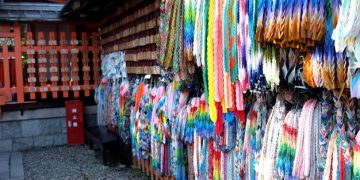Japanese Souvenir Shopping: Spot Authentic Crafts & Avoid Fakes

Navigating the vibrant world of Japanese souvenir shopping requires a keen eye to distinguish authentic crafts from cheap counterfeits. Understanding traditional artistry, material quality, and reputable vendor practices is key to acquiring genuine keepsakes that reflect Japan’s rich cultural heritage and avoiding disappointment.
Embarking on a journey through Japan offers a unique opportunity to immerse oneself in a culture rich with history, artistry, and unparalleled craftsmanship. For many travelers, bringing a piece of this experience home, something tangible that captures the essence of their adventure, is just as important as the journey itself. This is where Japanese souvenir shopping: how to spot authentic crafts and avoid counterfeits becomes a crucial skill. The allure of exquisite traditional items, from delicate ceramics to intricate textiles, can be profound. However, like any popular tourist destination, Japan’s markets can also present a landscape where genuine artistry mingles with mass-produced imitations. Understanding how to discern the authentic from the artificial is not just about protecting your wallet; it’s about honoring the heritage, skill, and dedication of the artisans who pour their lives into these creations. This guide will equip you with the knowledge and confidence to make truly meaningful purchases, ensuring your souvenirs are not just mementos, but genuine treasures.
The art of Japanese craftsmanship: a rich heritage
Japanese craftsmanship is not merely the production of goods; it is a profound art form rooted in centuries of tradition, precision, and a deep respect for materials. Each piece, whether a delicate ceramic bowl or an intricately woven textile, often carries a story, a history, and the spirit of its maker. This deep cultural connection distinguishes true Japanese crafts from mere souvenirs. Understanding the historical context and the philosophy behind these creations is the first step in appreciating and identifying authentic items when you’re Japanese souvenir shopping.
Many traditional Japanese crafts trace their origins back centuries, evolving alongside the nation’s spiritual beliefs, social structures, and aesthetic sensibilities. For instance, the art of ceramics (yakimono) varies dramatically by region, with each area developing unique glazes, firing techniques, and forms, such as Kyoto’s Kiyomizu-yaki or Okinawa’s Ryukyu-yaki. Similarly, textile arts like kimono weaving or indigo dyeing boast intricate processes passed down through generations. The value in these items lies not just in their beauty but in the labor, knowledge, and time invested in their creation. True craftsmanship often involves specialized skills, meticulous attention to detail, and a reverence for the natural materials used.
Understanding regional specialities
Japan is a tapestry of distinct regional cultures, and this diversity is beautifully reflected in its crafts. Each prefecture or city often boasts a unique speciality, born from local resources, historical contexts, and specific artisan lineage. Knowing these regional specialities can be a powerful tool in your search for authenticity. A souvenir from Kyoto, for example, might ideally be a delicate Kiyomizu-yaki ceramic piece, while from Hokkaido, you might seek out Ainu wood carvings. Researching these regional connections before you travel can significantly enhance your shopping experience and help you identify items that are truly representative of their origin.
-
Kiyomizu-yaki (Kyoto Ceramics)
Known for elaborate decoration and intricate designs on pottery and porcelain, often featuring traditional Japanese motifs.
-
Arita-yaki (Saga Ceramics)
Famous for beautiful porcelain with vibrant overglaze enamels, often in blue, red, and gold, highly prized for its elegance.
-
Imari-yaki (Saga Ceramics)
A sub-category of Arita-yaki, specifically known for its export-oriented designs during the Edo period, often with bold, colorful patterns.
-
Wajima-nuri (Ishikawa Lacquerware)
Distinguished by its durability and intricate decoration, often involving gold or silver powder (maki-e) on black or vermillion lacquer.
-
Tsugaru-nuri (Aomori Lacquerware)
Characterized by its unique, multi-layered lacquer finish that creates a mottled, stone-like appearance.
-
Banshu Hammock (Hyogo Hand-dyed Textiles)
Traditionally produced textiles, particularly known for indigo dyeing and ikat (kasuri) weaving techniques.
The dedication to quality in Japanese craftsmanship is unparalleled. Artisans often spend years, even decades, perfecting their techniques. This pursuit of perfection, known as “shokunin kishitsu” (artisan spirit), means that true crafts are rarely mass-produced. Instead, they are the result of passionate dedication, often incorporating time-consuming, traditional methods. This is why understanding the background of these crafts is invaluable; it helps you appreciate the investment of skill and time that defines genuine Japanese artistry, making your selections during Japanese souvenir shopping much more meaningful.
Key indicators of authenticity: what to look for
When you’re engaged in Japanese souvenir shopping, distinguishing genuine articles from mass-produced imitations can be challenging but not impossible. Authentic Japanese crafts possess certain characteristics that set them apart, often related to their materials, construction, and the care taken in their creation. Learning to recognize these indicators will empower you to make informed purchases and avoid disappointment.
One of the most immediate signs of authenticity is the material quality. Genuine Japanese crafts often use high-quality, natural materials that feel substantial and display natural imperfections or textures. For instance, authentic wood carvings will show the natural grain of the wood, and high-quality ceramics will have a unique glaze and a satisfying weight. Conversely, mass-produced items often use cheaper, synthetic materials that feel light, flimsy, or overly uniform. Pay attention to the texture, weight, and even the smell of the item. Natural materials often have subtle variations in color or pattern that machine-made goods lack.
Another crucial indicator is craftsmanship and finish. Authentic traditional crafts exhibit meticulous attention to detail. Joints in wooden items fit perfectly, stitching in textiles is even and tight, and painted or lacquered surfaces are smooth and free of blemishes. Look for signs of handwork – slight irregularities that indicate human touch rather than machine precision. Imposters, on the other hand, often reveal sloppy finishes, visible glue residue, poorly aligned components, or overly bright, unnatural colors. Hand-painted details will show brushstrokes and unique variations, while machine-printed designs will be perfectly uniform and lack depth.

Hallmarks and artist signatures
Many genuine Japanese crafts, especially high-value items, will bear the hallmarks or signatures of the artisan or workshop. These marks can be found on the base of ceramic pieces, subtle stamps on textiles, or engraved on metalwork. While not every authentic item will be signed (especially older pieces or those from smaller, lesser-known workshops), the presence of a clear, deliberate signature is a strong indicator of authenticity and pride in craftsmanship. If possible, research the artisan or workshop; reputable makers often have an established history and reputation. Be wary of generic “Made in Japan” stickers on items that purport to be traditional crafts, as these are often applied to mass-produced goods, especially those destined for tourist markets.
Finally, consider the packaging and presentation. Authentic, higher-end Japanese crafts are often sold with careful, subtle packaging that emphasizes the item’s delicate nature and importance. This might include custom-fitted wooden boxes, silk cloths, or detailed explanatory labels (though these might be in Japanese). Counterfeits, conversely, might come in flimsy plastic, overly flashy, or generic packaging that provides little information about the item’s origins or makers. While not an infallible rule, the care taken in packaging can reflect the care taken in creation.
By paying close attention to these elements – material quality, meticulous craftsmanship, the presence of artisan marks, and thoughtful presentation – you can significantly improve your ability to identify and procure truly authentic Japanese crafts during your Japanese souvenir shopping adventures.
Where to shop for authentic Japanese souvenirs
The location of your Japanese souvenir shopping can be just as crucial as knowing what to look for. While tourist centers and major department stores offer convenience, seeking out specialized shops, artisan studios, and local markets often yields the most authentic and high-quality finds. The environment in which an item is sold can tell you a lot about its origins and the vendor’s commitment to genuine craftsmanship.
Specialty craft shops and galleries are arguably the best places to buy authentic Japanese souvenirs. These establishments often specialize in a particular type of craft—be it ceramics, lacquerware, textiles, or traditional paper. Store owners are usually knowledgeable about their products, able to explain the history, techniques, and the artisans behind each piece. Prices in these stores may be higher, but you are paying for guaranteed authenticity, quality, and often a direct connection to the artisan community. Many of these shops also offer an opportunity to witness artisans at work or participate in workshops, further deepening your appreciation for the craft.
Reputable department stores and museum shops
Major Japanese department stores like Isetan, Mitsukoshi, or Takashimaya, particularly in cities like Tokyo and Kyoto, have dedicated sections for traditional Japanese crafts. While they cater to a broader market, their strong
reputations mean they typically stock genuine goods from established brands and artisans. Prices will generally be fixed and higher than in local markets, but the quality and authenticity are usually assured. Museum shops, especially those attached to cultural museums or art galleries, also often carry curated selections of authentic, high-quality crafts that directly relate to the museum’s collections. These are excellent places for unique, culturally significant souvenirs.
-
Department Stores
Reliable for quality and authenticity, offering a diverse array of crafts from well-known brands. Prices are typically higher.
-
Museum Shops
Curated selections of culturally relevant and often high-quality crafts, aligning with the museum’s focus and standards.
-
Local Artisan Workshops
Direct purchase from makers, often offering unique pieces and insights into creation processes. Great for distinctive, original finds.
-
Traditional Shopping Streets (Shotengai)
Offers a blend of local goods, from daily necessities to some authentic crafts. Requires careful discernment to spot genuine items.
While tourist traps and souvenir stalls, particularly around popular landmarks, might offer tempting prices, these are the most likely places to find mass-produced counterfeits. Items here are often generic, lack intricate detail, and are made from inferior materials. While it’s tempting to grab a quick souvenir, exercise extreme caution in these environments. If an item seems too cheap for the purported craftsmanship, it likely is. Always compare prices and quality with those found in more reputable stores before making a purchase. Your efforts in seeking out these specialized venues will be largely rewarded with a truly authentic piece of Japanese culture, making your Japanese souvenir shopping expedition a memorable success.
Common counterfeit items and how to avoid them
As you delve into Japanese souvenir shopping, it’s essential to be aware of the most commonly counterfeited items. Knowing what to look out for can significantly reduce your chances of purchasing a fake. While Japanese craftsmanship is revered, its popularity also makes it a target for counterfeiters who aim to capitalize on the desire for authentic Japanese goods.
One of the most frequently counterfeited categories is traditional ceramics and pottery. Items like matcha bowls (chawan), sake sets, and decorative plates are often replicated with lower-quality materials and less-skilled labor. Authentic ceramics will often have a unique texture, a consistent glaze free of bubbles or imperfections, and a satisfying weight. Counterfeits may feel lighter, have a rougher base, display uneven glazing, or feature poorly reproduced hand-painted designs that lack depth and detail. Look closely at the bottom of ceramic pieces for artisan marks or kiln stamps, which are typically absent or crudely replicated on fakes.
Textiles and apparel
Kimono, yukata, and traditional fabrics are also common targets. Genuine silk kimonos, for instance, are expensive due to the intricate weaving and dyeing processes involved. Counterfeits often use synthetic materials like polyester, which feel different to the touch and lack the drape and luminosity of real silk. Authentic indigo-dyed fabrics (Aizome) will have a distinct, slightly earthy smell and a color that deepens over time, whereas fakes might fray easily or have an unnaturally vibrant, uniform blue that hints at chemical dyes. Examine the stitching, embroidery, and overall finish; genuine items will have impeccable craftsmanship, while fakes may show loose threads, uneven patterns, or poor print quality.

Japanese swords (katanas) and replicas sold as souvenirs are often low-quality imitations. While true antique katanas are exceptionally rare and highly regulated, even modern decorative replicas can be poorly made. Genuine blades, even non-functional ones, will be more substantial, have a better balance, and feature finely crafted details on the hilt (tsuka) and guard (tsuba). Counterfeits often feel flimsy, have poorly wrapped handles, and lack the subtle elegance of a well-made blade. Always purchase swords or sword replicas from reputable, specialized vendors who can explain the materials and construction, and be wary of incredibly cheap offerings in tourist areas.
Miniature crafts and knick-knacks
Items like Maneki-neko (lucky cats), Daruma dolls, and various wooden or plastic trinkets are widely available and frequently counterfeited. While many of these are designed as affordable souvenirs, authentic versions still involve some level of thoughtful design and quality materials. Fakes often appear flimsy, have paint defects, lack intricate details, or use cheap, shiny plastics. Pay attention to the eyes on Daruma dolls (which should be unpainted until a wish is made) and the quality of the paintwork on Maneki-neko. Opt for items from smaller, local shops rather than large souvenir networks for a better chance of finding a unique, handcrafted piece, effectively navigating the landscape of Japanese souvenir shopping.
By staying vigilant and knowing the tell-tale signs of authentic craftsmanship versus mass-produced replicas, you can truly enjoy your Japanese souvenir shopping experience and bring home items that are genuine reflections of Japan’s artistic legacy.
Supporting local artisans and ethical shopping
Beyond simply identifying authentic souvenirs, a deeper layer to Japanese souvenir shopping involves engaging in ethical practices that support local artisans and preserve traditional crafts. Your purchasing choices can directly impact the livelihoods of skilled individuals and the continuation of invaluable cultural heritage. Ethical shopping means not only buying genuine products but also ensuring that your transactions benefit the communities and artists who create them.
One of the most direct ways to support local artisans is to purchase directly from their workshops or studios, or from small, independent shops that have direct relationships with the makers. When you buy from these sources, a larger portion of the price goes directly to the artisan, rather than being absorbed by intermediaries or large retail chains. Many traditional craft villages throughout Japan welcome visitors and offer opportunities to meet the artisans, witness their techniques, and purchase items straight from the source. This not only ensures authenticity but also provides a more profound, personal connection to your souvenir.
Choosing fair trade and certified products
While “fair trade” labels might not be as common for individual artisans in Japan as they are for larger-scale international goods, some organizations or co-operatives might offer certifications. Inquire about the origin and production methods of the crafts. Reputable vendors will be transparent about where their products come from and how they are made. Opting for items that emphasize sustainable practices, ethically sourced materials, and fair wages for labor ensures that your purchases contribute positively to the local economy and environment. Look for indications that the materials are locally sourced and that the production process adheres to environmental standards, especially important in natural materials like wood or traditional dyes.
Another aspect of ethical shopping is the preservation of traditional techniques. Many Japanese crafts are facing challenges as younger generations opt for modern careers, leading to a decline in the number of skilled artisans. By purchasing authentic, handcrafted goods, you are creating demand for these traditional skills, encouraging artisans to continue their work, and inspiring new generations to learn and preserve these invaluable cultural practices. Your investment in an authentic craft is an investment in the future of Japanese artistry.
Ultimately, ethical Japanese souvenir shopping is about making conscious choices. It’s about valuing the human effort, skill, and cultural significance embedded in each handcrafted item. By prioritizing purchases from artisans and smaller, ethical businesses, you not only acquire unique, high-quality souvenirs but also become a part of the effort to sustain Japan’s rich legacy of craftsmanship for years to come.
Caring for your Japanese souvenirs
Once you’ve made your authentic purchases during your Japanese souvenir shopping, understanding how to properly care for them is essential to ensure their longevity and preserve their beauty. Japanese crafts are often delicate and made with natural materials, requiring specific handling and maintenance to keep them in pristine condition. Proper care reflects your appreciation for the artistry and craftsmanship embedded in each piece.
For ceramics and pottery, gentle handling is paramount. Avoid exposing them to extreme temperature changes, as this can cause cracking. Handwashing with mild soap and lukewarm water is generally recommended, especially for items with delicate glazes or hand-painted designs. Avoid harsh abrasive cleaners or dishwashers, which can chip or dull the finish. For items like traditional matcha bowls (chawan), some enthusiasts recommend seasoning them by soaking them in water before first use, as this can help prevent staining and strengthen the clay. Always store ceramics in a stable place where they won’t be easily knocked over or subjected to vibrations.
Textiles and fabrics
Silk kimonos, yukata, and other traditional fabrics require careful attention. Silk, in particular, is a delicate fiber that can be damaged by direct sunlight, moisture, and harsh chemicals. It’s best to store silk items in a cool, dark, and dry place, preferably in a breathable garment bag. For cleaning, professional dry cleaning is often the safest option. If handwashing is necessary for sturdy cotton items, use cold water and a mild, pH-neutral soap, then air dry away from direct sunlight. Avoid wringing or twisting the fabric. Ironing should be done on a low setting, with a cloth barrier between the iron and the fabric, especially for silk.
-
Ceramics
Handwash with mild soap, avoid extreme temperatures, store securely.
-
Silk Fabrics
Dry clean or handwash gently with cold water and mild soap, avoid direct sunlight.
-
Lacquerware
Wipe with a soft, damp cloth, avoid abrasive cleaners, do not soak or expose to extreme heat.
-
Wood Crafts
Dust with a soft cloth, keep away from direct sunlight and humidity, do not soak.
Lacquerware (urushi), while durable, also requires specific care. Lacquer is sensitive to excessive heat, direct sunlight, and abrasive materials. Never put lacquerware in a dishwasher or microwave. Clean it by gently wiping with a soft, damp cloth and a mild detergent if necessary, then immediately dry it with another soft cloth. Avoid prolonged soaking. When storing, keep lacquerware away from direct light and significant temperature fluctuations to prevent cracking or discoloration.
For wood crafts and carvings, the main enemies are humidity fluctuations, direct sunlight, and excessive dryness, which can cause cracking or warping. Dust regularly with a soft, dry cloth. Avoid using water or chemical cleaners unless specifically recommended for the type of wood and finish. Keeping wooden items in a stable environment with moderate humidity is ideal. By taking these simple yet crucial steps, your authentic Japanese souvenirs will remain beautiful and cherished reminders of your journey for many years to come, truly making your efforts in Japanese souvenir shopping worthwhile.
| Key Point | Brief Description |
|---|---|
| 🎨 Craftsmanship | Authentic items show meticulous detail, high-quality materials, and signs of handwork. |
| 📍 Shopping Locations | Prioritize specialty shops and artisan studios over generic tourist stalls. |
| 🔍 Counterfeit Signs | Beware of uneven finishes, synthetic materials, and unusually low prices. |
| 🧼 Care Guide | Proper cleaning and storage are vital for preserving the beauty and longevity of your souvenirs. |
Frequently asked questions about Japanese souvenir shopping
The best authentic Japanese souvenirs often include regional ceramics (like Kiyomizu-yaki), traditional textiles (silk scarves, small indigo-dyed items), lacquerware, hand-forged knives, and exquisite paper products (washi). Look for items that reflect local history, materials, and artisan techniques, ensuring they are not mass-produced imitations. These items carry the spirit of Japanese craftsmanship.
Handmade ceramics usually have subtle imperfections, such as slight variations in shape, glaze, or texture, indicating a human touch. Machine-made pieces are often perfectly symmetrical, uniform, and lack character. Look for a potter’s mark or signature on the base, which is a strong indicator of a handcrafted item. The weight and feel can also differentiate them.
Duty-free shops typically sell a mix of genuine branded goods and more generic, mass-produced items aimed at tourists. While they are convenient, they are not the primary source for unique, artisanal crafts. For truly authentic, handmade souvenirs, it’s generally better to visit specialty craft stores, artisan workshops, or reputable department store sections dedicated to traditional crafts within the city.
Authentic Japanese lacquerware (urushi) is made from natural tree sap and has a deep, subtle luster. Fakes often use synthetic coatings, appearing overly shiny or plastic-like. Genuine pieces are smooth to the touch and resistant to liquids, while counterfeits might show rough patches or easily chip. High-quality lacquerware is durable and often signed; be wary of cheap, flimsy items.
In most retail settings in Japan, bargaining is not a common practice and is often considered impolite, particularly in established stores, department stores, or artisan shops. Prices are usually fixed. While rare exceptions might occur in very small, independent market stalls, it’s generally best to respect the stated prices and not attempt to negotiate for crafts or high-quality goods.
Conclusion
Mastering the art of Japanese souvenir shopping: how to spot authentic crafts and avoid counterfeits is an enriching endeavor that transforms a simple transaction into a meaningful cultural exchange. By understanding the hallmarks of genuine craftsmanship—from the quality of materials and the precision of finish to the subtle presence of an artisan’s mark—you empower yourself to make informed choices. Shopping in specialized stores and directly from artisans not only guarantees authenticity but also provides vital support to the custodians of Japan’s exceptional artistic heritage. These carefully chosen souvenirs become more than mere trinkets; they evolve into cherished treasures, each telling a story of tradition, skill, and respectful appreciation. Your journey through Japan offers a unique opportunity to bring home a piece of its soul, ensuring that your memories are forever linked to the beauty and authenticity of its timeless crafts.





